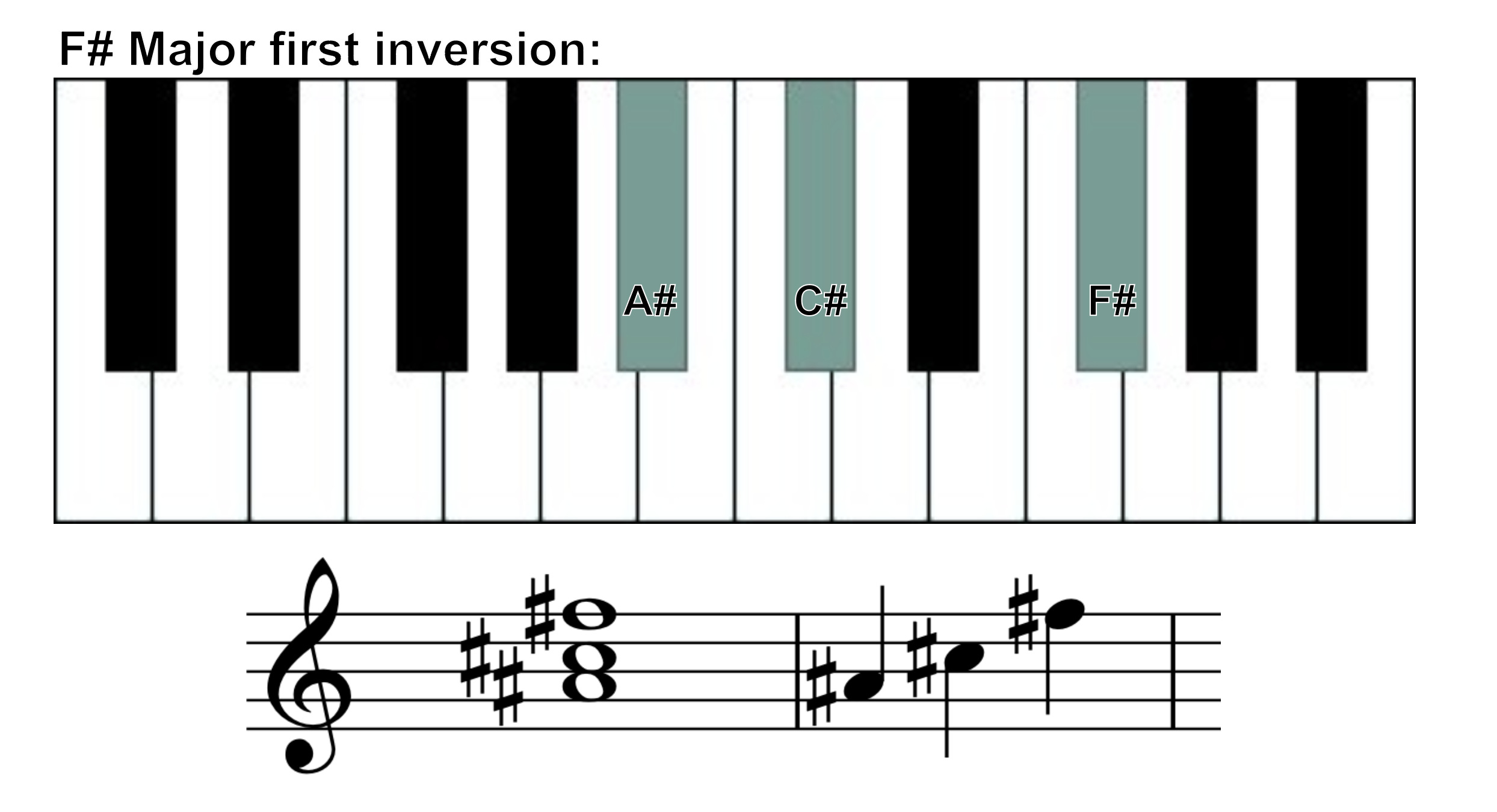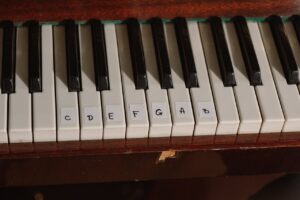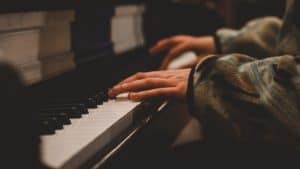The F-sharp chord adds a bold and unique sound to your piano playing.
It’s one of the trickier chords to start with but it’s worth learning as it’s in all kinds of music from classical to pop. Master the F-sharp chord and you’ll have more expression in your music and it will sound even more dynamic. At Skoove we’ll guide you through every step to help you play complex chords like this with confidence.
To play the F# chord you need three notes: F#, A#, C#. Start with F#, the black key just before the group of three black keys. Then add A# and C#, the next two black keys above it. Press all three together and you’ll hear the sharp, clear sound of the F-sharp chord.

Notes in the F# major chord
The F# major piano chord consists of three notes F#, A# and C#. These three notes together create the F# major major triad, which gives the chord its major sound.
To play this chord in its root position (basic form) with your right hand, use these fingers:
- C# – Fifth finger (5)
- A# – Third finger (3)
- F# – Thumb (1)
For the left hand, use the following fingers:
- C# – Thumb (1)
- A# – Third finger (3)
- F# – Fifth finger (5)
The inversions of the F# major chord
The inversions of the F# major piano chord are made by rearranging the notes while playing the same chord. These chord inversions allow for distinct harmonic textures and better chord transitions.
The F# major piano chord has two inversions:
- First Inversion: This inversion moves F# to the top, placing A# as the lowest note.
- Second Inversion: This inversion shifts both F# and A# to the top, making C# the lowest note.
How to play F# major first inversion?
To play the first inversion of the F# major piano chord, start with A# as the lowest note. Next, play C# above it and finally, place F# at the top. This gives new life with a different voicing that is great for smooth chord transitions.

For the right hand, use these fingers:
- F# – Fifth finger (5)
- C# – Middle finger (3)
- A# – Thumb (1)
For the left hand, use these fingers:
- F# – Thumb (1)
- C# – Third finger (3)
- A# – Fifth finger (5)
How to play F# major second inversion?
To play the 2nd inversion of the F# major piano chord, start with C# as the lowest note. Then, play F# above it, and finally, add A# at the top. This variant gives the chord a fresh feel and can make it simpler to transition fluidly between chords.

For the right hand, use these fingers:
- A# – Fifth finger (5)
- F# – Middle finger (3)
- C# – Thumb (1)
For the left hand, use these fingers:
- A# – Thumb (1)
- F# – Third finger (3)
- C# – Fifth finger (5)
F# major chord progression
The F# major chord progression appears in an extensive array of musical genres, such as pop, rock, jazz and classical. These chord progressions support dynamic movement and emotional depth in these songs. An F# major chord progression often includes chords like F#, B, C# and D#m.
Here are some popular F# major piano chord progressions:
- F# – B – C# – C#
- D#m – B – C# – F#
- F# – B – F# – C#
- B – C# – B – F#
Playing these chord patterns regularly will improve your familiarity with F# major on piano and make transitions between chords feel more natural.
These progressions highlight the versatility of the F# major chord progression, offering a range of moods from uplifting to powerful. They are a great way to put your knowledge of piano chords to the test. To understand these chord symbols and how to play them, check out Skoove’s tailor-made beginner chord progression courses.
Piano chords generator
💡 If you are reading this from a mobile device, rotate it to display the tool in full width.
1. Click on “Chords”
2. Choose the “Root” of the chord
3. Choose the “Chord qualities” (major, minor, etc.)
4. Click “Display”
Popular songs to play with the F# major piano chord
Frank Sinatra – All the Things You Are
Stay Cold – BTS
Author of this blog post:
Susana Pérez Posada

With over seven years of piano education and a deep passion for music therapy, Susana brings a unique blend of expertise to Skoove. A graduate in Music Therapy from SRH Hochschule Heidelberg and an experienced classical pianist from Universidad EAFIT, she infuses her teaching with a holistic approach that transcends traditional piano lessons. Susana’s writings for Skoove combine her rich musical knowledge with engaging storytelling, enriching the learning experience for pianists of all levels. Away from the piano, she loves exploring new places and immersing herself in a good book, believing these diverse experiences enhance her creative teaching style.
Published by Lydia Ogn from the Skoove team













